

CONTENTS
1 INTRODUCTION
2 STEEL TAPE
3 OPTICAL FILM
4 DIRECTLY-CUT DISKS
5 MAGNETIC TAPE
6 PORTABLE RECORDING
7 CARTS AND DARTS
8 DIGITAL RECORDING AND PLAYOUT
Steel tape had proved useful, but was awkward and not of the best sound quality. During the war, monitors became aware that the Germans were evidently able to make high-quality recordings, since Hitler's speeches were being broadcast at all hours in what sounded like 'live' quality: during the invasion a number of radio stations were captured, equipped with recorders using ¼-inch tape on a cellulose acetate base, coated with a fine layer of iron oxide (Fe2O3) - paper had been in use as a base just before the war but broke so easily that it was impracticable.
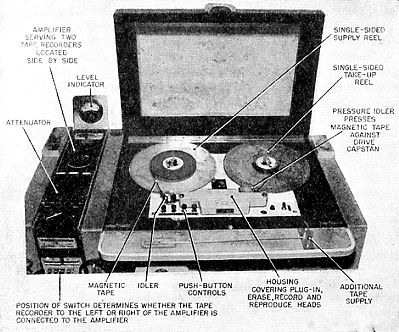 The
BBC acquired some
Magnetophone machines (left) in 1946 on an experimental basis,
and
these were used in the early stages of the new Third Programme
to
record and playback performances of operas from Germany (live
relays
being problematic because of the unreliability of the landlines
in the
immediate post-war period). The tapes ran at 30
inches/second (ips), and the flexible base provided much better
contact
with
the head: the main reason for the improvement in the sound was
the
addition of a high-frequency current at 100kHz to the audio
signal,
which avoided the inherent distortion in the magnetization
process.
The
BBC acquired some
Magnetophone machines (left) in 1946 on an experimental basis,
and
these were used in the early stages of the new Third Programme
to
record and playback performances of operas from Germany (live
relays
being problematic because of the unreliability of the landlines
in the
immediate post-war period). The tapes ran at 30
inches/second (ips), and the flexible base provided much better
contact
with
the head: the main reason for the improvement in the sound was
the
addition of a high-frequency current at 100kHz to the audio
signal,
which avoided the inherent distortion in the magnetization
process.
These machines were used until 1952, though most of the work continued to be done using the established media; but from 1948 a new British model became available from EMI: the BTR1. Though in many ways clumsy, its quality was good, and as it wasn't possible to obtain any more Magnetophones it was an obvious choice. There was some difficulty with the tape: early EMI tape was very prone to print-through (where the magnetic image on one layer causes the next layer on the spool to pick up a faint version, causing pre- and post-echoes, often through several layers) - I've been told that the BBC told EMI to sort this out or they would stop using tape. The effect remained in later years, but much diminished and normally not a serious problem.
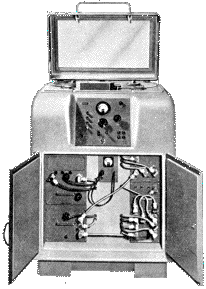
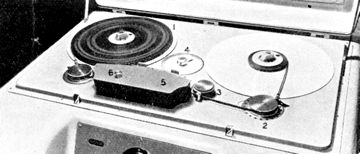 We
still had one of
the BTR1s in the 1960s and I've had the doubtful pleasure of
using it.
It
was rather a nightmare: the operating buttons were connected to
the
mechanics by Bowden cable and were stiff, so you rapidly got a
sore
thumb. Worse, the head-block, because of its size, had to be
outside
the tape path with the heads facing away from you (and the tape
wound
oxide-out) so that marking the tape with a chinagraph pencil
involved
leaning over - I'm six feet tall and I found it awkward: shorter
colleagues found it nearly impossible. In the early days, at 30
ips,
people probably just grabbed the tape and cut it - at that speed
you
could afford to miss by a couple of inches as long as you
weren't doing
music editing. (Early editing was done by holding the tape in
mid-air
and using scissors - I once asked a colleague who had done this
how he
managed to get the angle consistent: he said, 'Oh, we didn't
bother'.
Of course at 30 ips it wouldn't matter much, but one of my more
eccentric colleagues insisted on using scissors at 7½ ips, and
his
joints were a menace.)
We
still had one of
the BTR1s in the 1960s and I've had the doubtful pleasure of
using it.
It
was rather a nightmare: the operating buttons were connected to
the
mechanics by Bowden cable and were stiff, so you rapidly got a
sore
thumb. Worse, the head-block, because of its size, had to be
outside
the tape path with the heads facing away from you (and the tape
wound
oxide-out) so that marking the tape with a chinagraph pencil
involved
leaning over - I'm six feet tall and I found it awkward: shorter
colleagues found it nearly impossible. In the early days, at 30
ips,
people probably just grabbed the tape and cut it - at that speed
you
could afford to miss by a couple of inches as long as you
weren't doing
music editing. (Early editing was done by holding the tape in
mid-air
and using scissors - I once asked a colleague who had done this
how he
managed to get the angle consistent: he said, 'Oh, we didn't
bother'.
Of course at 30 ips it wouldn't matter much, but one of my more
eccentric colleagues insisted on using scissors at 7½ ips, and
his
joints were a menace.)
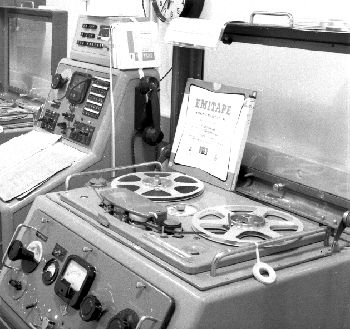 In the
early 1950s the EMI BTR 2 became
available
(left); a much improved machine and generally liked. It became
the
standard in recording channels (rooms) for many years, and was
in use
until the end of the 1960s. The machines were responsive, could
run up
to speed quite quickly, had light-touch operating buttons,
forward-facing heads, and were quick and easy to do the finest
editing
on.
In the
early 1950s the EMI BTR 2 became
available
(left); a much improved machine and generally liked. It became
the
standard in recording channels (rooms) for many years, and was
in use
until the end of the 1960s. The machines were responsive, could
run up
to speed quite quickly, had light-touch operating buttons,
forward-facing heads, and were quick and easy to do the finest
editing
on.
The tape speed was eventually standardized at 15 ips for almost all work at Broadcasting House, and at 15 ips for music and 7½ ips for speech at Bush House. The acetate base was replaced by PVC which broke less easily (though when it did it stretched, whereas acetate snapped cleanly and was easy to repair: stretched PVC was a disaster). The standard 10½ inch reels ran for half an hour at 15 ips with standard thickness tape (1.5 thousandths of an inch - 'long play' tape at 1 thousandth was available for domestic use but stretched too easily for broadcast use). In the end Bush House abandoned 15 ips for pretty well everything: and in 1971 embarked on an ill-advised experiment to use 3¾ ips to cut down on the considerable cost of tape. We all told them it wouldn't work: and it didn't - after a few weeks it was abandoned as the quality couldn't be maintained and joints tended to lift off the head in passing through.
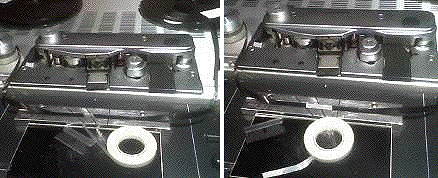 The
BTR 1 and 2 revolutionized broadcasting. The
quality was
indistiguishable from live on transmission, and the finest
editing
could
be done quickly and easily by practised engineers; instead of
film
cement or soldering irons the simple application of sticky tape
to the
edited tape held in a block made the process much simpler
(right).
Variety programmes
could be recorded on Sunday, allowing the performers to appear
in
Music-Halls during the week, and the producer could edit the
programme
to tighten it up, get it to the correct length, and remove
dubious
jokes which had been slipped in (always a problem in the 1930s).
The
machines' speed reliability over 30 minutes was not perfect, so
the
tradition arose of programmes running 29 minutes and 30 seconds,
with a
1 minute music playout, so that an error of ±30 seconds could be
accomodated (this was before programme junctions were cluttered
up with
two minutes of trails).
The
BTR 1 and 2 revolutionized broadcasting. The
quality was
indistiguishable from live on transmission, and the finest
editing
could
be done quickly and easily by practised engineers; instead of
film
cement or soldering irons the simple application of sticky tape
to the
edited tape held in a block made the process much simpler
(right).
Variety programmes
could be recorded on Sunday, allowing the performers to appear
in
Music-Halls during the week, and the producer could edit the
programme
to tighten it up, get it to the correct length, and remove
dubious
jokes which had been slipped in (always a problem in the 1930s).
The
machines' speed reliability over 30 minutes was not perfect, so
the
tradition arose of programmes running 29 minutes and 30 seconds,
with a
1 minute music playout, so that an error of ±30 seconds could be
accomodated (this was before programme junctions were cluttered
up with
two minutes of trails).
It also became normal to 'de-umm' pre-recorded interviews - particularly in the World Service where the interviewee was often not completely fluent in English: the most edits I ever had (I actually counted the number of pieces of sticky tape as they went past on-air) was 75 in a three-minute interview, though this was abnormally high.
Up until about 1965 there were no tape machines in Bush House or Broadcasting House studios: Studio Managers handled the mixing panel and played disks, but never touched tape - all recording, editing and playback was done in channels (except that occasionally at Broadcasting House a smaller tape machine was in use in the studio, but with an engineer in attendance. Producers weren't allowed to handle tape either - the engineers sent recordings to a central library and all handling of tapes was carried out by Engineering Department).
With the increased reliability of tape the decision was taken to equip studios with tape machines - initially for playback only, though eventually local recording was introduced and Studio Managers had to become fully conversant with the machines (there was some resistance to this as SMs were usually from a non-technical background). BTR2s were too big for studio use, and various other machines became available.
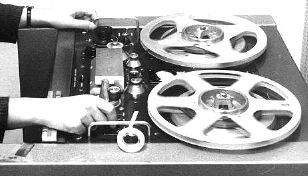
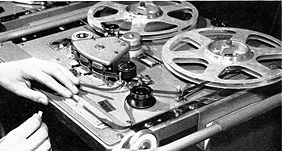 Broadcasting
House used the EMI TR90 (left) and a Philips machine which was
lightweight but very easy and quick to use: Bush House used the
Leevers-Rich, initially in the widely-disliked Mark 2 version
(right)
but later with the push-button operated Mark 4 - which was an
improvement, though the complicated tape lace-up path was still
not
popular.
Broadcasting
House used the EMI TR90 (left) and a Philips machine which was
lightweight but very easy and quick to use: Bush House used the
Leevers-Rich, initially in the widely-disliked Mark 2 version
(right)
but later with the push-button operated Mark 4 - which was an
improvement, though the complicated tape lace-up path was still
not
popular.
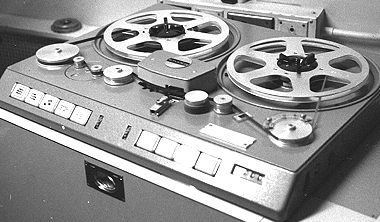 The
Studer range of machines had become pretty well the studio
recording
industry standard by the 1970s, and gradually these replaced the
aging
BTR2s (which were now giving flutter and general reliability
problems,
with no spares available) in recording rooms and studios: the
photo on
the right is of the first model to arrive at Bush House, and
later
similar but refined versions were eventually installed in the
larger
studios. As delivered the machines had a motorized pair of
scissors
which popped out of a slot before the final roller, and was
supposed to
be used to edit the tape (you found the place then moved the
tape on by
an amount shown on the right-hand roller): it's a daft idea, and
after
someone had managed to snip a tape while it was being played up
a line
to Scotland (who thought it hilarious) the scissors were
disabled to
prevent
further accidents.
The
Studer range of machines had become pretty well the studio
recording
industry standard by the 1970s, and gradually these replaced the
aging
BTR2s (which were now giving flutter and general reliability
problems,
with no spares available) in recording rooms and studios: the
photo on
the right is of the first model to arrive at Bush House, and
later
similar but refined versions were eventually installed in the
larger
studios. As delivered the machines had a motorized pair of
scissors
which popped out of a slot before the final roller, and was
supposed to
be used to edit the tape (you found the place then moved the
tape on by
an amount shown on the right-hand roller): it's a daft idea, and
after
someone had managed to snip a tape while it was being played up
a line
to Scotland (who thought it hilarious) the scissors were
disabled to
prevent
further accidents.
Gradually pre-recorded rather than live programmes - or inserts - became the norm. Recording in sections and subsequent editing and mixing enabled broadcast plays to be be assembled with less rehearsal, but something of the 'edge' of classic live plays such as Under Milk Wood and The Dark Tower was lost in the process. Of course there were new hazards: accidental erasure (fortunately not common, but it could happen: someone once placed a 4038 microphone - which contains a very powerful magnet - on top of a reel of tape, with obvious results), tapes dropped down lift-shafts or taken home in error (more than one Studio Manager has been woken in the night and told to bring a recording needed for overnight transmission back now), or stretched by mishandling (as an engineer I once saved an SM's skin by reconstructing the damaged word 'United' from syllables copied from elsewhere in the recording, and I don't claim any uniqueness about that).
So the advent of magnetic tape recording had more effect on radio than anything since its inception (and a similar process was taking place in television with the invention of video recording); and one of its major contributions was in providing the ability to make location recordings without lugging a car-load of touchy disk-cutting equipment about: portable recording will be examined on the next page.
1 INTRODUCTION
2 STEEL TAPE
3 OPTICAL FILM
4 DIRECTLY-CUT DISKS
5 MAGNETIC TAPE
6 PORTABLE RECORDING
7 CARTS AND DARTS
8 DIGITAL RECORDING AND PLAYOUT

Steel tape had proved useful, but was awkward and not of the best sound quality. During the war, monitors became aware that the Germans were evidently able to make high-quality recordings, since Hitler's speeches were being broadcast at all hours in what sounded like 'live' quality: during the invasion a number of radio stations were captured, equipped with recorders using ¼-inch tape on a cellulose acetate base, coated with a fine layer of iron oxide (Fe2O3) - paper had been in use as a base just before the war but broke so easily that it was impracticable.
 The
BBC acquired some
Magnetophone machines (left) in 1946 on an experimental basis,
and
these were used in the early stages of the new Third Programme
to
record and playback performances of operas from Germany (live
relays
being problematic because of the unreliability of the landlines
in the
immediate post-war period). The tapes ran at 30
inches/second (ips), and the flexible base provided much better
contact
with
the head: the main reason for the improvement in the sound was
the
addition of a high-frequency current at 100kHz to the audio
signal,
which avoided the inherent distortion in the magnetization
process.
The
BBC acquired some
Magnetophone machines (left) in 1946 on an experimental basis,
and
these were used in the early stages of the new Third Programme
to
record and playback performances of operas from Germany (live
relays
being problematic because of the unreliability of the landlines
in the
immediate post-war period). The tapes ran at 30
inches/second (ips), and the flexible base provided much better
contact
with
the head: the main reason for the improvement in the sound was
the
addition of a high-frequency current at 100kHz to the audio
signal,
which avoided the inherent distortion in the magnetization
process.These machines were used until 1952, though most of the work continued to be done using the established media; but from 1948 a new British model became available from EMI: the BTR1. Though in many ways clumsy, its quality was good, and as it wasn't possible to obtain any more Magnetophones it was an obvious choice. There was some difficulty with the tape: early EMI tape was very prone to print-through (where the magnetic image on one layer causes the next layer on the spool to pick up a faint version, causing pre- and post-echoes, often through several layers) - I've been told that the BBC told EMI to sort this out or they would stop using tape. The effect remained in later years, but much diminished and normally not a serious problem.

 We
still had one of
the BTR1s in the 1960s and I've had the doubtful pleasure of
using it.
It
was rather a nightmare: the operating buttons were connected to
the
mechanics by Bowden cable and were stiff, so you rapidly got a
sore
thumb. Worse, the head-block, because of its size, had to be
outside
the tape path with the heads facing away from you (and the tape
wound
oxide-out) so that marking the tape with a chinagraph pencil
involved
leaning over - I'm six feet tall and I found it awkward: shorter
colleagues found it nearly impossible. In the early days, at 30
ips,
people probably just grabbed the tape and cut it - at that speed
you
could afford to miss by a couple of inches as long as you
weren't doing
music editing. (Early editing was done by holding the tape in
mid-air
and using scissors - I once asked a colleague who had done this
how he
managed to get the angle consistent: he said, 'Oh, we didn't
bother'.
Of course at 30 ips it wouldn't matter much, but one of my more
eccentric colleagues insisted on using scissors at 7½ ips, and
his
joints were a menace.)
We
still had one of
the BTR1s in the 1960s and I've had the doubtful pleasure of
using it.
It
was rather a nightmare: the operating buttons were connected to
the
mechanics by Bowden cable and were stiff, so you rapidly got a
sore
thumb. Worse, the head-block, because of its size, had to be
outside
the tape path with the heads facing away from you (and the tape
wound
oxide-out) so that marking the tape with a chinagraph pencil
involved
leaning over - I'm six feet tall and I found it awkward: shorter
colleagues found it nearly impossible. In the early days, at 30
ips,
people probably just grabbed the tape and cut it - at that speed
you
could afford to miss by a couple of inches as long as you
weren't doing
music editing. (Early editing was done by holding the tape in
mid-air
and using scissors - I once asked a colleague who had done this
how he
managed to get the angle consistent: he said, 'Oh, we didn't
bother'.
Of course at 30 ips it wouldn't matter much, but one of my more
eccentric colleagues insisted on using scissors at 7½ ips, and
his
joints were a menace.) In the
early 1950s the EMI BTR 2 became
available
(left); a much improved machine and generally liked. It became
the
standard in recording channels (rooms) for many years, and was
in use
until the end of the 1960s. The machines were responsive, could
run up
to speed quite quickly, had light-touch operating buttons,
forward-facing heads, and were quick and easy to do the finest
editing
on.
In the
early 1950s the EMI BTR 2 became
available
(left); a much improved machine and generally liked. It became
the
standard in recording channels (rooms) for many years, and was
in use
until the end of the 1960s. The machines were responsive, could
run up
to speed quite quickly, had light-touch operating buttons,
forward-facing heads, and were quick and easy to do the finest
editing
on.The tape speed was eventually standardized at 15 ips for almost all work at Broadcasting House, and at 15 ips for music and 7½ ips for speech at Bush House. The acetate base was replaced by PVC which broke less easily (though when it did it stretched, whereas acetate snapped cleanly and was easy to repair: stretched PVC was a disaster). The standard 10½ inch reels ran for half an hour at 15 ips with standard thickness tape (1.5 thousandths of an inch - 'long play' tape at 1 thousandth was available for domestic use but stretched too easily for broadcast use). In the end Bush House abandoned 15 ips for pretty well everything: and in 1971 embarked on an ill-advised experiment to use 3¾ ips to cut down on the considerable cost of tape. We all told them it wouldn't work: and it didn't - after a few weeks it was abandoned as the quality couldn't be maintained and joints tended to lift off the head in passing through.
 The
BTR 1 and 2 revolutionized broadcasting. The
quality was
indistiguishable from live on transmission, and the finest
editing
could
be done quickly and easily by practised engineers; instead of
film
cement or soldering irons the simple application of sticky tape
to the
edited tape held in a block made the process much simpler
(right).
Variety programmes
could be recorded on Sunday, allowing the performers to appear
in
Music-Halls during the week, and the producer could edit the
programme
to tighten it up, get it to the correct length, and remove
dubious
jokes which had been slipped in (always a problem in the 1930s).
The
machines' speed reliability over 30 minutes was not perfect, so
the
tradition arose of programmes running 29 minutes and 30 seconds,
with a
1 minute music playout, so that an error of ±30 seconds could be
accomodated (this was before programme junctions were cluttered
up with
two minutes of trails).
The
BTR 1 and 2 revolutionized broadcasting. The
quality was
indistiguishable from live on transmission, and the finest
editing
could
be done quickly and easily by practised engineers; instead of
film
cement or soldering irons the simple application of sticky tape
to the
edited tape held in a block made the process much simpler
(right).
Variety programmes
could be recorded on Sunday, allowing the performers to appear
in
Music-Halls during the week, and the producer could edit the
programme
to tighten it up, get it to the correct length, and remove
dubious
jokes which had been slipped in (always a problem in the 1930s).
The
machines' speed reliability over 30 minutes was not perfect, so
the
tradition arose of programmes running 29 minutes and 30 seconds,
with a
1 minute music playout, so that an error of ±30 seconds could be
accomodated (this was before programme junctions were cluttered
up with
two minutes of trails).It also became normal to 'de-umm' pre-recorded interviews - particularly in the World Service where the interviewee was often not completely fluent in English: the most edits I ever had (I actually counted the number of pieces of sticky tape as they went past on-air) was 75 in a three-minute interview, though this was abnormally high.
Up until about 1965 there were no tape machines in Bush House or Broadcasting House studios: Studio Managers handled the mixing panel and played disks, but never touched tape - all recording, editing and playback was done in channels (except that occasionally at Broadcasting House a smaller tape machine was in use in the studio, but with an engineer in attendance. Producers weren't allowed to handle tape either - the engineers sent recordings to a central library and all handling of tapes was carried out by Engineering Department).
With the increased reliability of tape the decision was taken to equip studios with tape machines - initially for playback only, though eventually local recording was introduced and Studio Managers had to become fully conversant with the machines (there was some resistance to this as SMs were usually from a non-technical background). BTR2s were too big for studio use, and various other machines became available.

 Broadcasting
House used the EMI TR90 (left) and a Philips machine which was
lightweight but very easy and quick to use: Bush House used the
Leevers-Rich, initially in the widely-disliked Mark 2 version
(right)
but later with the push-button operated Mark 4 - which was an
improvement, though the complicated tape lace-up path was still
not
popular.
Broadcasting
House used the EMI TR90 (left) and a Philips machine which was
lightweight but very easy and quick to use: Bush House used the
Leevers-Rich, initially in the widely-disliked Mark 2 version
(right)
but later with the push-button operated Mark 4 - which was an
improvement, though the complicated tape lace-up path was still
not
popular. The
Studer range of machines had become pretty well the studio
recording
industry standard by the 1970s, and gradually these replaced the
aging
BTR2s (which were now giving flutter and general reliability
problems,
with no spares available) in recording rooms and studios: the
photo on
the right is of the first model to arrive at Bush House, and
later
similar but refined versions were eventually installed in the
larger
studios. As delivered the machines had a motorized pair of
scissors
which popped out of a slot before the final roller, and was
supposed to
be used to edit the tape (you found the place then moved the
tape on by
an amount shown on the right-hand roller): it's a daft idea, and
after
someone had managed to snip a tape while it was being played up
a line
to Scotland (who thought it hilarious) the scissors were
disabled to
prevent
further accidents.
The
Studer range of machines had become pretty well the studio
recording
industry standard by the 1970s, and gradually these replaced the
aging
BTR2s (which were now giving flutter and general reliability
problems,
with no spares available) in recording rooms and studios: the
photo on
the right is of the first model to arrive at Bush House, and
later
similar but refined versions were eventually installed in the
larger
studios. As delivered the machines had a motorized pair of
scissors
which popped out of a slot before the final roller, and was
supposed to
be used to edit the tape (you found the place then moved the
tape on by
an amount shown on the right-hand roller): it's a daft idea, and
after
someone had managed to snip a tape while it was being played up
a line
to Scotland (who thought it hilarious) the scissors were
disabled to
prevent
further accidents.Gradually pre-recorded rather than live programmes - or inserts - became the norm. Recording in sections and subsequent editing and mixing enabled broadcast plays to be be assembled with less rehearsal, but something of the 'edge' of classic live plays such as Under Milk Wood and The Dark Tower was lost in the process. Of course there were new hazards: accidental erasure (fortunately not common, but it could happen: someone once placed a 4038 microphone - which contains a very powerful magnet - on top of a reel of tape, with obvious results), tapes dropped down lift-shafts or taken home in error (more than one Studio Manager has been woken in the night and told to bring a recording needed for overnight transmission back now), or stretched by mishandling (as an engineer I once saved an SM's skin by reconstructing the damaged word 'United' from syllables copied from elsewhere in the recording, and I don't claim any uniqueness about that).
So the advent of magnetic tape recording had more effect on radio than anything since its inception (and a similar process was taking place in television with the invention of video recording); and one of its major contributions was in providing the ability to make location recordings without lugging a car-load of touchy disk-cutting equipment about: portable recording will be examined on the next page.



